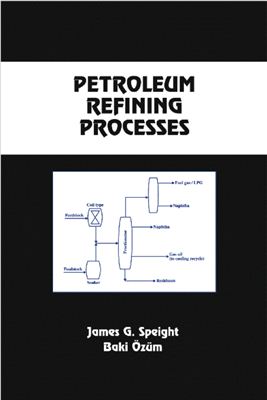Marcel Dekker Inc. : 2002, 722 p. ISBN:0824705998.
This work highlights contemporary approaches to resource utilization and provides comprehensive coverage of technological advances in residuum conversion. It illustrates state-of-the-art engineering methods for the refinement of heavy oils, bitumen, and other high-sulphur feedstocks.
The book is divided into three parts: "Feedstock Terminology, Availability, and Evaluation", "Engineering Aspects of Refining", and "'Refining". Each part takes the render through the steps necessary fur crude oil evaluation and refining.
Part I (Chapters 1-4) duals with the prerefining steps and outlines how to evaluate a feedstock prior to applying refining processes.
Part II (Chapters 5-12) will be of particular interest to the engineer who needs to understand the mathematics of chemical reaction, reaction kinetics, transport phenomena, and reactor engineering. Part III (Chapters 13-20) describes in detail, with relevant process data, the various processes that can be applied to a variety of feedstocks. All processes are described with sufficient detail to explain their operation.
By presenting the evolutionary changes that have occurred to date, this book will satisfy the needs of engineers and scientists at all levels from academia to the refinery, helping them to understand the refining processes and prepare for new changes in the industry.
This work highlights contemporary approaches to resource utilization and provides comprehensive coverage of technological advances in residuum conversion. It illustrates state-of-the-art engineering methods for the refinement of heavy oils, bitumen, and other high-sulphur feedstocks.
The book is divided into three parts: "Feedstock Terminology, Availability, and Evaluation", "Engineering Aspects of Refining", and "'Refining". Each part takes the render through the steps necessary fur crude oil evaluation and refining.
Part I (Chapters 1-4) duals with the prerefining steps and outlines how to evaluate a feedstock prior to applying refining processes.
Part II (Chapters 5-12) will be of particular interest to the engineer who needs to understand the mathematics of chemical reaction, reaction kinetics, transport phenomena, and reactor engineering. Part III (Chapters 13-20) describes in detail, with relevant process data, the various processes that can be applied to a variety of feedstocks. All processes are described with sufficient detail to explain their operation.
By presenting the evolutionary changes that have occurred to date, this book will satisfy the needs of engineers and scientists at all levels from academia to the refinery, helping them to understand the refining processes and prepare for new changes in the industry.

